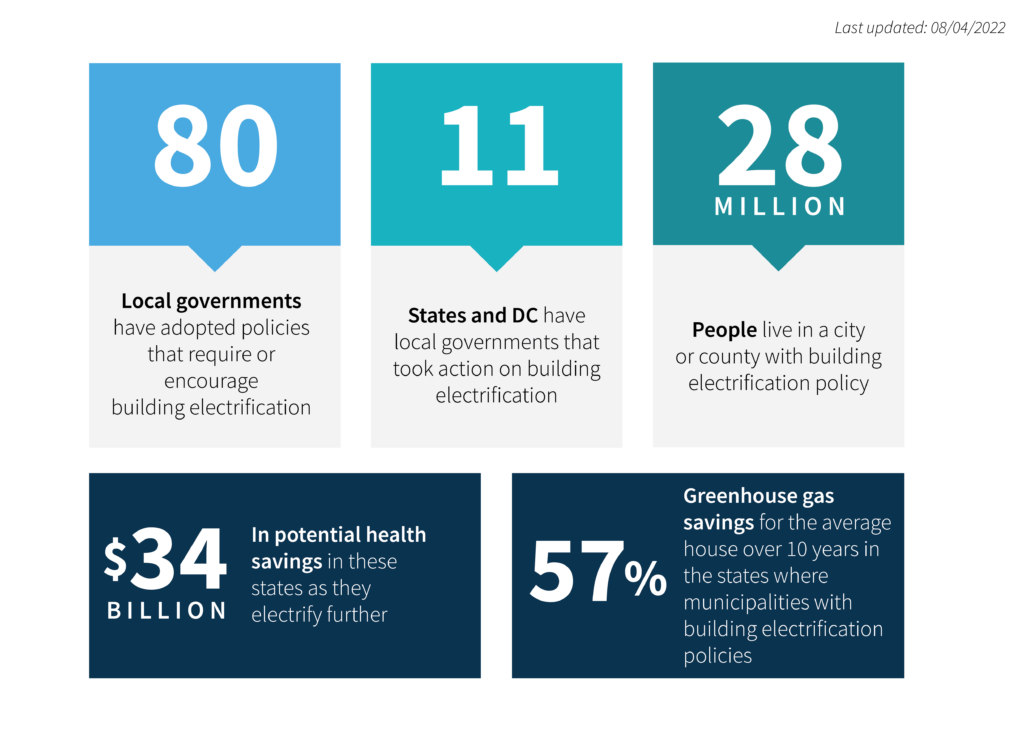- Across the United States, 80 cities and counties have adopted policies that require or encourage the move off fossil fuels to all-electric homes and buildings.
- As of August 2022, nearly 28 million people across 11 states live in a jurisdiction where local policies favor fossil fuel-free, healthy buildings.
- And the momentum behind these policies keeps building — dozens more local governments have strong commitments to decarbonize their buildings stock, which will soon become formal policy.
Local Building Electrification Momentum at a Glance

Source: Building Decarbonization Coalition, US Census Bureau, RMI, Sierra Club
This national wave of action is motivated by the numerous benefits — in terms of climate, air quality, health, economics, resilience, and safety — of shifting from fossil fuels to zero-emissions electric appliances.
Air Quality
Fossil fuel appliances by releasing harmful pollutants like nitrogen oxides (NOx) that lead to smog. In fact, gas appliances emit more than twice as much NOxas gas power plants in the United States, despite consuming less gas. Many of the same states and regions with the worst smog pollution also have elevated levels of NOx emissions from appliances. Electrification can eliminate this pollution source and help us all breathe cleaner air. Learn More.
Health
Fossil fuel extraction and appliance pollution harm public health and disproportionately impact BIPOC (Black, Indigenous, and people of color) and low-income communities. Due to systemic injustices, these communities have higher rates of illnesses, like asthma, that can be caused or exacerbated by appliance pollution. Exposure to fossil fuel appliance pollution in the United States led to over $65 billion in health impacts in 2017. BIPOC communities are exposed to nearly twice as much fine particulate (PM2.5) pollution from household gas appliances as White communities. These communities with heightened pollution exposure should be prioritized in the transition to electric appliances.
Economics
Across the country, all-electric single-family homes are less costly for builders and developers than building homes that require fossil fuel infrastructure. These cost savings allow developers to produce more market-rate and affordable housing units and endure other price fluctuations. Much of these savings are created by foregoing costly gas pipelines — which can carry a price tag as high as $15,000 per house.
Resilience
With more frequent extreme heat waves, access to air conditioning is a health and safety imperative for many communities across the world. Many Americans — especially BIPOC and low-income households — either lack access to air conditioning or cannot afford to run it. Equipping homes with electric heat pumps, which provide highly efficient heating and cooling, will help families ride out dangerous heat waves.
Safety
Transmitting gas through pipelines creates significant fire and explosion risks. Between 2010 and 2021, US gas pipeline incidents that were reported to the federal government, which make up only a fraction of the total, occurred once every two days on average. Of the 2,600 reported incidents, one-third resulted in fires and one-eighth in explosions. These incidents led to a total of 122 deaths and 600 injuries, and they cost communities nearly $4 billion.
Local governments across the nation are feeling the heat and are eager to help their residents and businesses get off fossil fuels like gas. With the help of local experts, they have created a range of policy solutions, including:
- Building code amendments — Local building codes set requirements for new construction and/or major renovations. Local governments can include incentives or requirements for electric appliances through ordinances or laws that amend the local or state building code. The appliances and building types that are covered can vary or be phased in over time, or building codes can require all-electric construction for all new buildings.
- Building performance standards — A building performance standard, or BPS, sets a performance target that a building owner must meet over time. It may be an emissions target, meaning a building must reduce its total pollution below a certain threshold, or an energy target, meaning a building must reduce its total energy usage below a certain threshold by a specified date. Building owners can choose which upgrades to pursue to comply with BPS, and electrifying appliances is typically the best option due to the energyand emissions savings that heat pumps deliver. These standards typically apply to large public, commercial, and multifamily buildings. Model BPS include incentives and financing to help with the retrofits, as well as financial penalties for noncompliance.
Local policies to restrict gas expansion and accelerate clean energy retrofits vary in form and detail based on the local context, illustrating a wealth of paths to eliminate climate and air pollution in homes and businesses. Leading examples of local action prioritize the unique needs of low-income and historically marginalized communities while providing a clear and decisive shift away from burning fossil fuels in buildings
This article was originally published by the Rocky Mountain Institute and is republished with permission.
Disclaimer: The articles expressed in this publication are those of the authors. They do not purport to reflect the opinions or views of Green Building Africa or our staff. The designations employed in this publication and the presentation of material therein do not imply the expression of any opinion whatsoever on the part Green Building Africa concerning the legal status of any country, area or territory or of its authorities.











